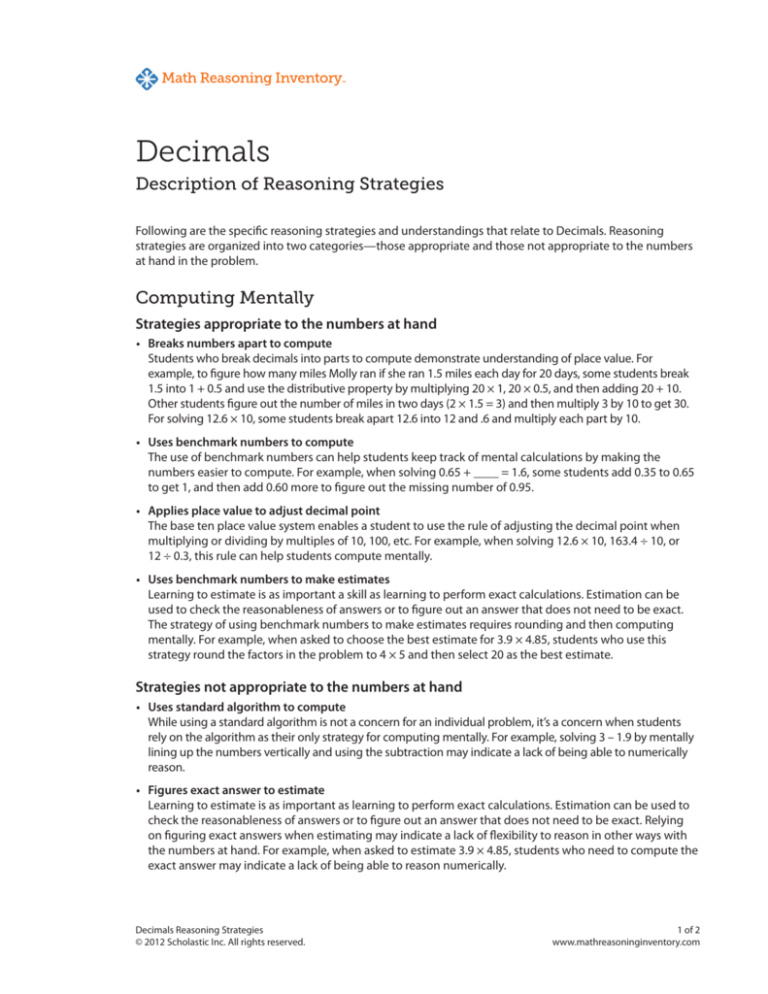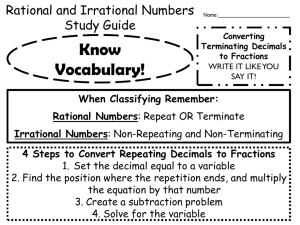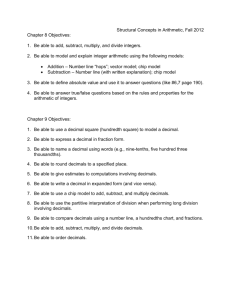
Decimals
Description of Reasoning Strategies
Following are the specific reasoning strategies and understandings that relate to Decimals. Reasoning
strategies are organized into two categories—those appropriate and those not appropriate to the numbers
at hand in the problem.
Computing Mentally
Strategies appropriate to the numbers at hand
• Breaks numbers apart to compute
Students who break decimals into parts to compute demonstrate understanding of place value. For
example, to figure how many miles Molly ran if she ran 1.5 miles each day for 20 days, some students break
1.5 into 1 + 0.5 and use the distributive property by multiplying 20 × 1, 20 × 0.5, and then adding 20 + 10.
Other students figure out the number of miles in two days (2 × 1.5 = 3) and then multiply 3 by 10 to get 30.
For solving 12.6 × 10, some students break apart 12.6 into 12 and .6 and multiply each part by 10.
• Uses benchmark numbers to compute
The use of benchmark numbers can help students keep track of mental calculations by making the
numbers easier to compute. For example, when solving 0.65 + ____ = 1.6, some students add 0.35 to 0.65
to get 1, and then add 0.60 more to figure out the missing number of 0.95.
• Applies place value to adjust decimal point
The base ten place value system enables a student to use the rule of adjusting the decimal point when
multiplying or dividing by multiples of 10, 100, etc. For example, when solving 12.6 × 10, 163.4 ÷ 10, or
12 ÷ 0.3, this rule can help students compute mentally.
• Uses benchmark numbers to make estimates
Learning to estimate is as important a skill as learning to perform exact calculations. Estimation can be
used to check the reasonableness of answers or to figure out an answer that does not need to be exact.
The strategy of using benchmark numbers to make estimates requires rounding and then computing
mentally. For example, when asked to choose the best estimate for 3.9 × 4.85, students who use this
strategy round the factors in the problem to 4 × 5 and then select 20 as the best estimate.
Strategies not appropriate to the numbers at hand
• Uses standard algorithm to compute
While using a standard algorithm is not a concern for an individual problem, it’s a concern when students
rely on the algorithm as their only strategy for computing mentally. For example, solving 3 – 1.9 by mentally
lining up the numbers vertically and using the subtraction may indicate a lack of being able to numerically
reason.
• Figures exact answer to estimate
Learning to estimate is as important as learning to perform exact calculations. Estimation can be used to
check the reasonableness of answers or to figure out an answer that does not need to be exact. Relying
on figuring exact answers when estimating may indicate a lack of flexibility to reason in other ways with
the numbers at hand. For example, when asked to estimate 3.9 × 4.85, students who need to compute the
exact answer may indicate a lack of being able to reason numerically.
Decimals Reasoning Strategies
© 2012 Scholastic Inc. All rights reserved.
1 of 2
www.mathreasoninginventory.com
Applying Understanding
• Models with mathematics to solve problems in context
Solving problems in contexts requires that students can model situations mathematically—relate situations
to the appropriate numerical operations and provide answers that relate to the problem contexts. For
example, to figure the cost of 10 pens when one pen costs $1.39, some students break apart $1.39 and
multiply. Other students apply place value and adjust the decimal point.
• Uses place value to compare
Comparing decimals requires that students understand place value. For example, to decide which is
smallest—0.32, 2.1, or 0.185—some students who apply understanding of place value eliminate 2.1 since
both of the other numbers are less than 1, and then compare the digits in the tenths places of the other
numbers to decide that 0.185 is the smallest. Students who lack understanding of place value may ignore
the decimal points in 0.32 and 0.185 and reason that 0.32 is smaller because 32 is less than 185.
• Relates decimals to fractions [several choices for D question 3]
It’s important for students to understand that decimals can be used to represent fractions and that
fractions can be represented as decimals (or percents). For example, to decide which is greater, 1/5 or 0.17,
some students decide that 1/5 is greater by renaming 1/5 as 0.20 or 20% and comparing to 0.17 or 17%.
Decimals Reasoning Strategies
© 2012 Scholastic Inc. All rights reserved.
2 of 2
www.mathreasoninginventory.com






